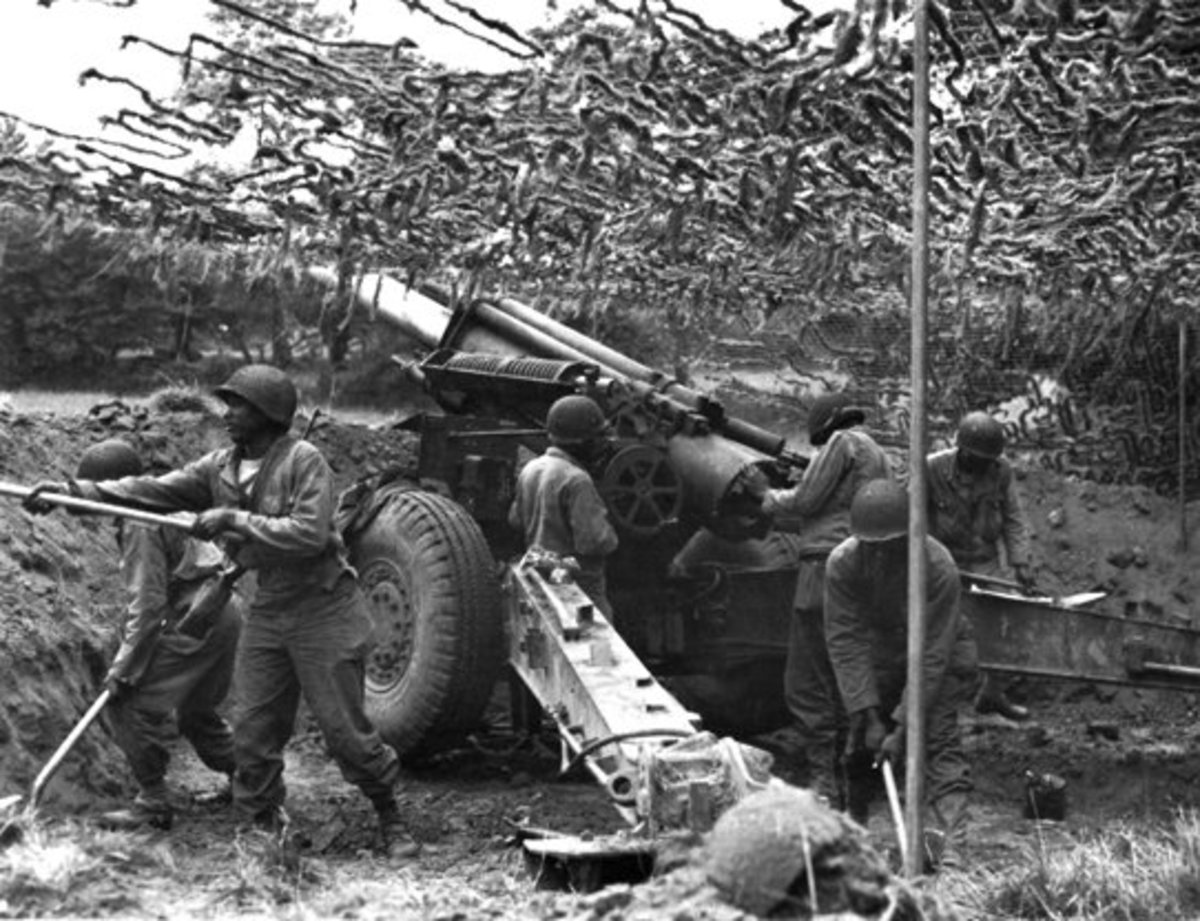Battle of The Bulge - December, 1944 - A/H
The following information
It looked like they were going to get to their goal about 80 miles away in Antwerp, Belgium. They were helped by the fact that the weather was so bad Allied planes could not get up in the air to fight them off.

They fought bravely under the same conditions, even though they were in a segregated unit because they were African Americans. 11 of their friends had been captured when the German attack began on December 16th, and were murdered in the corner of a cow field. We must never forget the sacrifice these men made so we could enjoy the freedom we have today.
Battle Of The Bulge:
December 16th, 1944-January 25th, 1945
By the beginning of December, 1944 the Allies had pushed the German Army all the way across Europe almost into Germany itself. The Allies stopped to bring up soldiers who were rested, and to build up huge supplies of food, weapons, ammo, and fuel.
In the mean time the German army was gathering together soldiers, cannons, tanks, and other supplies for one big try to push the Allies back across Europe. They gathered up between 200,000 to 500,000 men. They collected at least 1,800 tanks, and 1,900 cannons. ALL of this was done largely in secret.
On 16 December 1944, at 5:30 a.m., the Germans began the attack with a massive, 90-minute artillery (cannons) attack using 1,600 artillery pieces along a line 80 miles long where the U.S. and British troops were lined up.
It may have sounded like this
At first the Germans had great success, and pushed about 50 miles into Allied territory.
This map shows where the Germans came from, and where they went
It looked like they were going to get to their goal about 80 miles away in Antwerp, Belgium. They were helped by the fact that the weather was so bad Allied planes could not get up in the air to fight them off.
You can see the German goal, Antwerp, at the top of the map. The curvy red like shows how far they actually got
Their men advanced with confidence that Hitler’s plan would succeed.

Advancing confident German
Then the Allies started to fight back. We sent in our best troops, the 101st Airborne Division of paratroopers to Bastogne.
The Germans needed to capture this town because it was where a lot of roads came together.
They needed these roads so their tanks can go farther on the attack (Tanks can’t drive through hills and forests.).
The Battle of the Bulge happened in December and January. It snowed and was cold
The Germans needed to capture this town because it was where a lot of roads came together.
Bastogne is in the middle. Look at all of the roads going into it from the right, and coming out on the left
They needed these roads so their tanks can go farther on the attack (Tanks can’t drive through hills and forests.).
German tank on roads near Bastogne
The Germans eventually surrounded our paratroopers in Bastogne, and held them there from December 20th to December 27th. It was not an equal fight, because we had only 11,000 soldiers, and the Germans had 120,000. Medical supplies ran out, the men did not have heavy coats and blankets, there was not much food, cannons were limited to firing no more than 10 times a day, and then ONLY when they actually saw a German tank to shoot.
The weather was hard. Heavy snowstorms began. It was the coldest winter in that area in over 50 years. From December 16th, 1944 to January 29th, 1945 the temperature got above freezing only 8 times. It dropped below 15 degrees 10 times, once going as low as 5 degrees.
Tanks had to run their engines every ½ hour to keep from freezing up. Men had to urinate on their rifles and machine guns so they would work in the freezing temperatures.

This shows the temperatures in Bastogne from December 16th (on left) to January 29th (on right)
Tanks had to run their engines every ½ hour to keep from freezing up. Men had to urinate on their rifles and machine guns so they would work in the freezing temperatures.

***
This is what the fighting around Bastogne looked like
The brave men of the 101st were not the only ones there. The 969th Field Artillery (cannons that went with the foot soldiers) provided heavy cannon support for the U.S. soldiers.
The 969th Field Artillery firing at Germans. They were a segregated African American unit
Look at what they wrote on the board and the artillery shell itself
They fought bravely under the same conditions, even though they were in a segregated unit because they were African Americans. 11 of their friends had been captured when the German attack began on December 16th, and were murdered in the corner of a cow field. We must never forget the sacrifice these men made so we could enjoy the freedom we have today.
Eventually the Germans were pushed back when the Allies brought in as many as 500,000 extra soldiers. The blue arrows show that pushing.










Comments
Post a Comment